Latinos in Hollywood: Amplifying voices, expanding horizons
March 9, 2024

By Camilo Becdach, Tomás Lajous, Sheldon Lyn, Lucy Pérez, and Tony Toussaint
There are about 62 million Latinos in the United States; globally, the heritage of more than 650 million people falls into the broad “Latino” category. US Latinos account for more than $3 trillion of GDP, which would make them the fifth largest economy in the world if they were a country. Beyond this economic power, they are also avid consumers of Hollywood’s narratives and punch well above their weight in supporting the film and TV industry. Compared with a population share of 19 percent, US Latinos account for 24 percent of box office ticket sales and 24 percent of streaming subscribers. To put this into even sharper contrast, US Latinos see films 3.3 times a year, per capita, compared with 2.9 for Asian-Americans and 2.3 for White Americans.
Yet Latinos hold less than 5 percent of leading on-screen, off-screen, and executive leadership roles in US media, according to our research. Half of large media companies’ boardrooms include no Latino representation, and overall there is limited progress toward parity. As a result, the many facets of the Latino identity, from the United States and around the world, continue to be unseen or misrepresented on screens.
In this article, we describe how addressing opportunities unique to Hollywood could lead to a triple win of higher industry revenue, a broader and richer range of Latino stories for all audiences to enjoy, and a more hospitable workplace for Latino professionals. The industry could generate an additional $12 billion to $18 billion a year in annual revenue—about 7 to 10 percent of today’s $179 billion—if Latino representation in Hollywood improved, our research found (see sidebar “About the research”).4 This revenue increase could benefit participants across the value chain, from creatives, production, and studios to distribution and adjacent industries.
We examine how the US film and TV industry is missing out on that additional revenue by underrepresenting Latinos on- and off-screen and demonstrate that Latinos are largely underrepresented, especially in executive roles. We also discuss the barriers that make Hollywood a particularly challenging workplace for Latinos and propose several broad actions Hollywood leaders can consider to improve Latino representation in the industry and capture this growth opportunity.
The economic impact of underrepresenting Latinos in Hollywood
Latinos may be the largest per capita US consumers of media, but their culture and talent have also proved popular among non-Latino US and global audiences alike. Our analysis found that enabling adequate representation across the production process, as well as the side benefits of more volume, accuracy, and authenticity of the Latino experience, could lead to an additional $12 billion to $18 billion in annual revenue for the industry.5
Our analysis concluded that Hollywood films featuring Latino talent perform better at the box office. Worldwide revenue for movies with Latinos in above-the-line roles (such as producers, directors, writers, and lead actors) outperformed those without by more than 58 percent from 2013 to 2022 (Exhibit 1). Television shows with at least one Latino in an above-the-line role saw median ad impressions outperforming by 60 percent. This universal appeal to audiences, regardless of their own background or heritage, reinforces a largely untapped opportunity in Latino artistry and creative endeavors (see sidebar “The impact of Latino representation in music”).
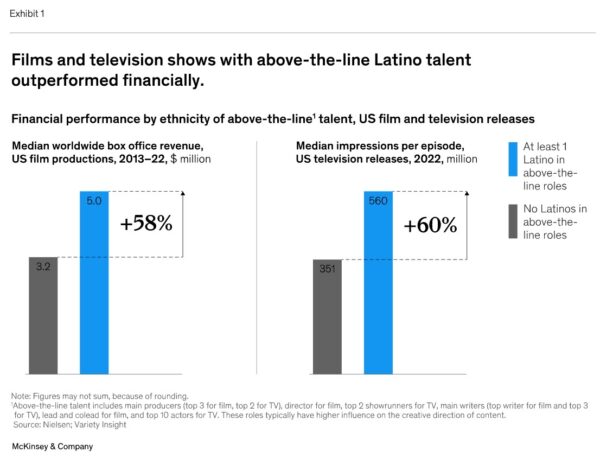
The enthusiasm of Latino audiences for film and television likely underpins some of this performance. Relative to their 19 percent share of the US population, Latinos are a significant driver of both opening-weekend attendance and total box office revenue. They account for 24 percent of film ticket sales, 29 percent of daily mobile TV viewers, and 24 percent of streaming subscribers. Latinos are the most avid filmgoers per capita in the United States. Moreover, Latino viewership doubles when Latinos are represented on- or off-screen (Exhibit 2).
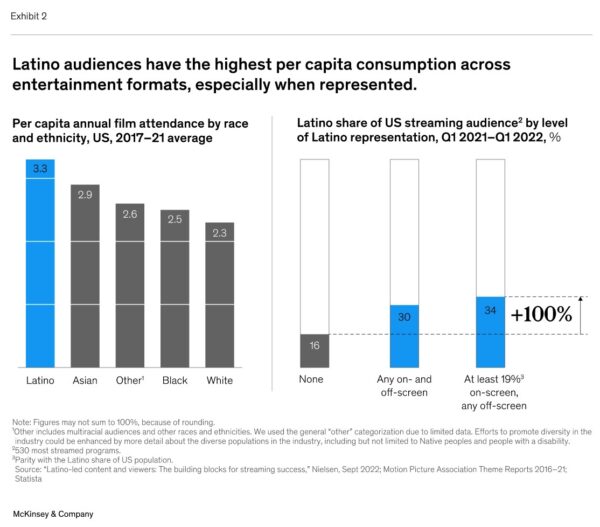
But a wide array of audiences aren’t the only ones enjoying this content—critics are also watching and applauding content made by or featuring Latinos. From 2013 to 2022, films with Latino above-the-line talent were about one-third more likely to be nominated for an Academy Award or Golden Globe than those without Latinos, and once nominated, they were more likely to win (Exhibit 3). Such recognition can be transformative in Hollywood. “Once you win awards, the movie doors open,” said one Latino director. “The head of a studio asked for a movie pitch, and I pitched the same movie I had pitched six years earlier. The original feedback was ‘macabre, amateurish’; then this time it’s ‘genius, unlike anything we have ever seen before.’”
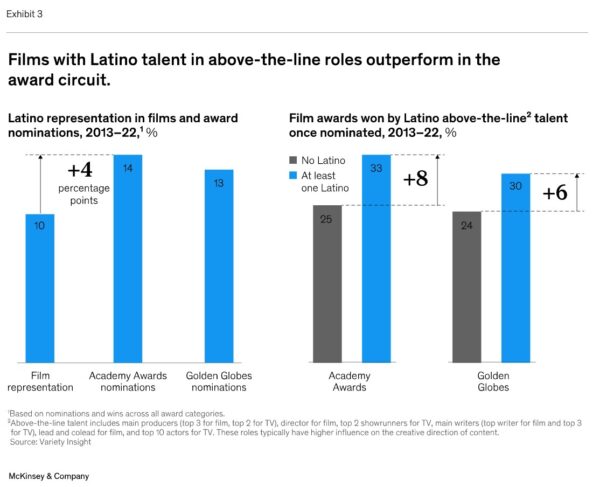
The state of Latino representation in Hollywood
There has been recent progress in representation across roles as well as in how Latinos are portrayed in stories. However, our interviews and the data suggest that the process of deciding which films are approved or how roles are cast often reinforces a narrow, and sometimes skewed, range of Latino stories. Lower representation in crucial behind-the-camera roles shows up in the types of stories that make it to audiences. For example, 27 percent of Latino-depicting films that have no Latinos in decision-making roles are crime-themed, a result that drops to 13 percent for films with Latino directors, producers, or writers. When led by non-Latinos, 8 percent of Latino-depicting films have family-oriented themes, increasing to 28 percent when Latinos are making storyline decisions (Exhibit 4).

From studios to talent agencies to trades, the representation of Latinos is low in virtually all decision-making positions that determine content narratives and influence hiring decisions. Only 5.5 percent of C-suite executives are Latino, according to available data for media companies in the United States.7
Compared with other minorities, Latinos are the most underrepresented group in Hollywood in above-the-line film roles (Exhibit 5), per available data. Latinos account for just 4 percent of lead or co-lead roles in US films, with similarly limited off-screen representation in director, producer, and writer roles. According to one Latino producer, “There is no shortage of actors. Almost a surplus of writers. The broken part is the business side: they don’t know how to support or market content made by Latinos.”
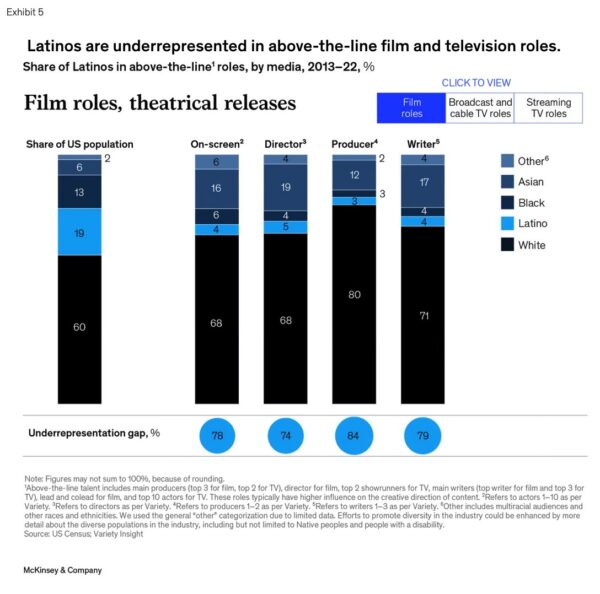
The same patterns are apparent in US television. On TV and streaming, Latinos account for 4 to 7 percent of on-screen talent, between 2 and 5 percent of writers’ rooms, and a very low share of showrunners—the decision makers who decide how stories are crafted, which ones are ultimately made, and who gets hired to make them. Our research found that non-Latino White showrunners are better represented by a factor of up to six.
Underrepresentation in creative leadership roles that determine hiring for other production roles contributes to the low number of opportunities available for aspiring talent. With fewer “at bats” compared with their White counterparts, Latinos receive about 33 percent fewer film credits on average in the first decade of their careers. And industry tenure has a direct relationship with production and marketing budgets: on average, filmmakers can aspire to budget increases of $4 million with each successive film credit.
As with Black representation in film and television,8 Latinos who rise to prominence in the industry play an outsize role in providing opportunities to other Latino talent: the likelihood of a Latino producer, writer, or lead signing on to a project is an average of 15-fold higher if the director or showrunner is Latino (Exhibit 6). Given that only 5 percent of films have Latino directors and 1 to 5 percent of TV and streaming shows have Latino showrunners, Latinos’ ceiling of opportunity is low. “The goal is to sign as many folks as I identify with,” said one Latino agent. “But the reality is there are not 20 jobs [for Latinos] out there. There may be jobs for two or three.”
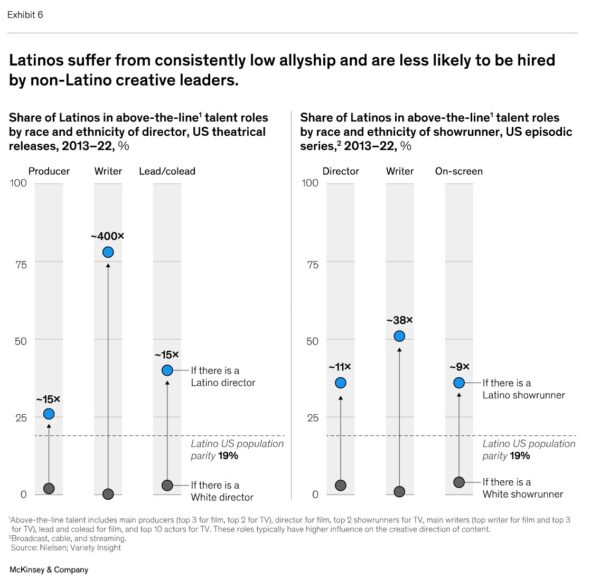
The barriers confronting Latinos in Hollywood
According to the Motion Picture Association, the American film and television industry supports 2.4 million jobs across 122,000 businesses. Of these jobs, 822,000 represent direct employment in the production, marketing, and distribution of movies and TV shows.9
Our research found that for Latinos, getting one of these jobs, and thriving in it, can be especially challenging. Many of our Latino interviewees recounted stories that highlight barriers to access—for example, the network-driven way in which many jobs are filled. Similarly, low early-tenure compensation in often high-cost cities effectively excludes many people from lower-income backgrounds, including most of the US Latino population.
In addition, Latinos encounter what several interviewees referred to as “low cultural competence,” which manifests in the industry’s failure to appreciate the community’s full potential as storytellers and executives. Latino respondents also spoke of instances in which they felt misunderstood and unwelcomed. And for those who eventually broke through, rising through the ranks to prized leadership positions can seem unattainable in any part of the ecosystem.
Hollywood movies and TV shows are typically greenlit by committee. Approvals for development and production require support from a large group of stakeholders, including studio and network leadership, financiers, talent agents, and production companies. These executive decision-making roles determine which projects are made, how much money to invest, and which creative talent to hire, while also influencing how the narrative is shaped throughout the development process. Below, we explore the main challenges facing Latinos in Hollywood based on our research.
The network effect
With fewer Latinos in the industry, there’s a smaller pool of experienced Latinos to connect with and learn from when exploring career opportunities in Hollywood. Our research found that there is a multiplier effect in driving diversity when decision makers are diverse themselves. When Latinos are in positions of creative leadership, they are on average 15 times more likely to hire other Latinos into key roles than their White counterparts. Developing a social network within Hollywood can be a vital component of securing a steady stream of work. “There are no applications for production jobs,” said one non-Latino executive. “A studio head hires division heads, and the division heads hire other people [they] know, and this cycle perpetuates—and as a result, Latinos don’t get hired.”
Breaking into the industry means facing another networking bottleneck: entry-level jobs are more accessible to those who have contacts in hiring positions, with many people finding success by turning to preexisting networks such as college alumni or family friends. In our interviews, many Latinos described the difficulty of developing a network without access to those university or family connections, especially given limited availability of forums or networking events for those outside of the industry.
Few true comparables
Hollywood’s desire to maximize returns by minimizing risk greatly affects content based on Latino experience. Most Hollywood executives have limited personal experience with Latino perspectives and narratives (see sidebar “What it means to be Latino”). Our interviewees commented that pitches based on Latino experience tend to require more evidence to support their potential. Pitches will point to similar intellectual property with established fan bases or existing comps, both of which have been historically limited for content led by Latinos in the United States. Vampire, zombie, and superhero movie pitches have plenty of successful comps to support their narrative and expected success. A Latino executive noted, “There’s not a lot of comps for Latino content, and if there are no comps, you have to fight harder for it.”
Without clear historical performance parallels, a pitch is considered a risky investment—one that executives are especially unlikely to choose during uncertain economic times. “Right now I’m not seeing representation reflected in boardrooms and executives,” said one Latino animator. “It’s the chicken and the egg problem: because there are no hits, they don’t want to make Latino movies. And because they don’t make Latino movies, there are no hits.”
Insufficient financial and creative power
Even when a pitch led by a Latino showrunner or storyteller is greenlit, it can still face an uphill battle during development, production, and release, both financially and creatively. Our analysis found that content led by Latinos in film and television regularly gets less investment in production and marketing: for example, Latino film directors receive 16 percent fewer marketing dollars and 25 percent lower production budgets, on average, than non-Latino White directors. The underinvestment is even more dramatic in television, where Latino showrunners get production budgets that average 53 percent lower than their White counterparts. One Latino senior executive recalled, “It was really hard to convince someone to give me eight to nine million, but when I partnered with a White colleague, that unlocked doors and got us in the room for greenlights.”
Latinas face an even larger deficit. According to our analysis of Hollywood films with US releases, production budgets for films by Latina directors are about six times smaller than for films by White male directors and around three times smaller than for films by other minority women. Above-the-line roles have the largest gender disparity across the industry; Latina film directors have the biggest gap.
Throughout the development process, executives send creative notes to refine narratives to appeal to target audiences. Multiple interviewees shared that the notes they received would often alter the cultural nuance of the script, simplifying or eliminating Latino portrayals. One Latino creative recalled a meeting with network executives: “They said the main character can’t be Latina, the first name needed to sound English with maybe a Latina last name, and that in order to greenlight, if you want to keep the Latina character, make her the sidekick. I said no.”
With few Latinos in positions of creative or financial power, there are not only fewer champions to advocate for the value of content led by Latinos but also fewer Latinos to inspire and empower others to join the industry. “We need more executives. That’s always been the problem. Executives are the gatekeepers, the champions. Someone who can see value and find it relatable, an advocate to help a project get more time to garner interest.”
General misunderstanding of Latinos and their experiences
The Latino community is a culturally diverse global diaspora (Exhibit 7). Our research shows that Latinos in Hollywood define their community very differently from how the industry defines it. The gap between these two definitions can affect the industry’s inclusion of Latino talent and content and has ripple effects on the image of Latinos in society more broadly.
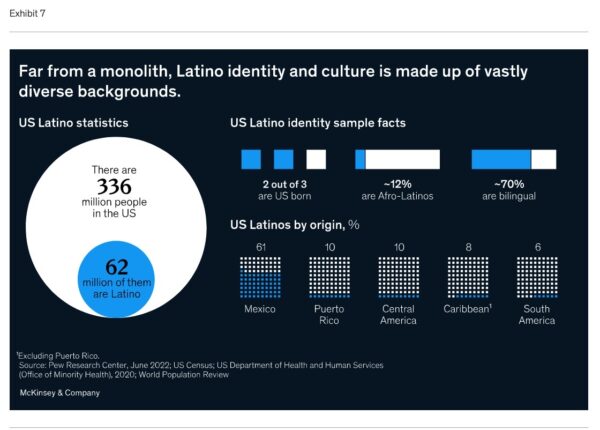
Many of the Latinos we spoke with self-identified based on their heritage (for example, Mexican, Mexican American, Cuban, and Cuban American), noting that they did not use the more generic “Latino” until starting a career in Hollywood. “We’re a whole variety of the rainbow, of accents, of different cultures across regions,” said one Latino actor. “We may all be considered Hispanic, but it’s ridiculous to put us all in the same category.”
Our interviewees told us that the Latino community is often oversimplified into a monolith. This can lead to stereotyping, with Latinos cast primarily as domestic help, immigrants, and criminals. “One of the biggest agents in TV told me, ‘This show will never see the light of day because the US market is not ready for Latinos speaking English and being protagonists,’” one Latino senior executive recalled. These experiences show that there is still work to do to create a full, holistic picture of the Latino identity. “Our job becomes convincing other people that our stories have universality and that people want to buy into cultures other than those most frequently explored,” a Latino agent said.
Interviewees noted that many of the Latino roles available at auditions continue to be one-dimensional roles associated with immigration, drug cartels, household services such as cleaning or gardening, or inner-city settings. This not only limits opportunities for Latinos in the industry but also has an effect on how the society perceives Latinos, perpetuating stereotypes and biases. Within Hollywood, several common themes emerged in our interviews.
A scarcity mentality. Several Latino interviewees reported experiencing a scarcity mentality in which few roles are available for many people. Interviewees report hearing executives justify the limited opportunities by saying their slate already has content led by Latinos, treating all Latino-related pitches as a single genre, rather than as different facets of a culture’s experience. One Latino senior executive said, “Every time we would pitch a Latino story, the buyers on the other side would say, ‘We already did a Mexican show; we’re not going to do another one.’”
Perpetual foreigners. Many interviewees said they were troubled by what they saw as Hollywood’s assumption that Latinos are “perpetual foreigners,” a community of outsiders regardless of citizenship or generational history—and its portrayal of them as such. One Latino director said, “Latinos are not considered American, even when they’re fourth-generation American, despite being integral to American society.”
Endurance. Many interviewees noted that breaking into Hollywood felt like a marathon. The only way to make it, they said, was to find a way to survive financially in the high-cost-of-living city with part-time jobs, side hustles, or primary careers—all of which cut into the time needed to audition, write scripts, or network within the industry. As one Latino executive said, “Hollywood is a place for people of means. You need other sources of income for the first five years.” This financial endurance is not a realistic endeavor for many Americans, including a large share of US Latinos, who earn on average around 30 percent less than their non-Latino White peers.10 Given their lack of a financial cushion, many Latinos are at higher risk of having to leave the industry when situations such as the recent actors and screenwriters’ strike limit their income. Several Latino interviewees also described having to demonstrate overqualifications to get entry-level jobs, earning graduate degrees, or building years of experience before landing an assistant role.
How Hollywood leaders can foster Latino representation
The industry could consider three broad actions to help capture the triple-win opportunity of greater economic output, a richer range of stories, and a more welcoming workplace for all: sponsoring Latinos into decision-making roles, investing in Latino talent and content, and portraying Latinos more realistically in film and TV. These actions are complex in execution and will require true partnership across organizations and their leaders.
Increasing the number of Latinos in decision-making roles
Our interviews suggest that success in the entertainment industry often hinges on connections with influential individuals in decision-making roles. As noted above, Latinos hire other Latinos for their projects 15 times more often than non-Latinos and have deeper insight into the Latino experience. The industry could take a first step in increasing Latino representation by making a concerted effort to sponsor Latinos into decision-making roles (for example, boards, C-suite positions, greenlighting committees, and leaders at talent agencies and guilds). This could lead to a deeper understanding of one of the industry’s largest consumer bases and improve the ability to better target content appropriate to that audience.
To achieve this goal, industry leadership could undertake the following actions:
- consider Latinos for C-suite and board roles through promotions within the industry and recruiting them from adjacent industries, such as advertising
- pair advanced-career Latinos with executive sponsors invested in their success and progression within the industry
- mount a mid-career development program focused on elevating Latinos into senior positions and monitor the pipeline of program “alumni” to support their placement and advancement within the industry
- seek more objective mechanisms to hire, reward, and promote talent in both creative and business roles, including improved use of performance metrics
Through these kinds of efforts, the entertainment industry can actively promote diverse above-the-line and executive talent and foster a more inclusive environment for the Latino community.
Other industries show that representation throughout an organization improves when Latinos rise to the top of their companies. For example, Target Corporation’s former chief marketing officer and current chief food, essentials, and beauty officer, Rick Gomez, has been relevant in the company’s efforts to address the Latino population. Target’s strides include the development of a Latino Business Council and partnerships with Latino organizations to improve the brand’s appeal for Latino customers and employees.
Investing in Latino talent and content
Major studios and networks have announced diversity, equity, and inclusion pledges in recent years. While these programs are a step forward, several interviewees noted that some have been underfunded or have seen their funding disappear quickly during budget-cutting exercises. Industry leaders want to support Latinos but, as discussed, decision makers may consider Latino-related content or roles to be risky, ultimately resulting in less Latino-led and Latino-themed content being greenlit.
We propose a series of actions aimed at promoting investment and lowering or spreading the perceived risk of new content and roles:
- commit to long-term investment in Latino content and talent, creating a systematic approach to increase diversity across above- and below-the-line roles
- use private capital and external investors for co-investment in Latino-led content to mitigate the perceived risk of this content
- actively seek to invest in and partner with Latino-led production companies to promote diverse content
- encourage studios and other industry players to fund opportunities for entry-level Latino professionals to connect and access vital industry networks
- look for diverse talent and stories in nontraditional mediums and platforms—for example, exploring social media influencers and content developers, as well as community theaters in underserved locations
- seek exceptions from guilds to enable non-unionized talent to enter the industry before unionizing, potentially eliminating a barrier to entry
The results of targeted investment in minority-led media have been well documented, particularly in the case of Black-owned content. Enterprises such as Tyler Perry Studios and the SpringHill Company have achieved remarkable success economically and socially by investing in diverse talent and content. In the case of Latinos, some early targeted investment efforts have had positive results, primarily led by Latino celebrities, but their limited reach and scale still leave untapped opportunities.
Embracing and accurately representing the multifaceted Latino identity
Parallel to increasing the diversity of boardrooms, sets, and screens, industry executives can take the following steps to portray Latinos more accurately and avoid stereotyping:
- conduct market research to better understand the diversity and multifaceted stories within the Latino community
- promote a deeper and more comprehensive understanding of the diversity and rich cultural heritage of the Latino community through engagement opportunities for all colleagues
- move beyond the concept of “Latino” as a character or story background when developing or adjusting content as well as demanding additional details (for example, place of origin to a city or town level, family background, languages, dialects, race, education, professional background, and religion) and ensure more authentic portrayals of characters
- ensure that Latinos are portrayed across a variety of roles (for example, lawyers, doctors, superheroes, and fairies), and with a range of backgrounds, races, and skin tones
In addition, advertisers could influence the direction of the industry by investing in content that authentically portrays the Latino experience.
Media showing Latinos and their stories across the spectrum have already gained both audience success and critical acclaim, including Pixar’s Coco; Disney+’s Andor; Netflix’s One Day at a Time, Wednesday, and The Last of Us; and CW’s Jane the Virgin. Empowering Latino storytellers to create authentic nonstereotypical portrayals is essential to shaping rich narratives that resonate with global audiences.
By providing more opportunities for Latino talent, Hollywood can not only tap into additional revenue of $12 billion to $18 billion annually but also foster a more inclusive and accurate portrayal of the Latino community. This, in turn, has the potential to help evolve society’s preconceived notions, reduce prejudices, and promote a more equitable and just representation of a large and growing worldwide community.
About the author(s)
Camilo Becdach and Sheldon Lyn are partners in McKinsey’s Southern California office, where Tony Toussaint is an associate partner. Tomás Lajous is a senior partner in the New York office, and Lucy Pérez is a senior partner in the Boston office.
The authors wish to thank Dom Furlong for her leadership throughout this research. We also wish to thank Marc Brodherson, Jathan Caldwell, Jonathan Dunn, Jenny Gao, Maria Gutierrez, Rehaan Kaul, Margret-Ann Natsis, Chiebuka Onwuzurike, Michael Pelts, Anastasia Perez Ternent, Alisha Rege, Katie Tang, and Anthony Ulloa for their contributions to this article.
The research is sponsored by McKinsey’s Technology, Media & Telecommunications (TMT) Practice. Our work has benefited from years of research and data gathering by the Latino Donor Collaborative, the Motion Picture Association, the McKinsey Institute for Latino Economic Mobility, the McKinsey Institute for Black Economic Mobility, Nielsen, and Variety Insight, among many others. McKinsey also wishes to acknowledge the anonymous contributions of the nearly 100 industry professionals who shared their career experiences to help shape the insights in this article.































